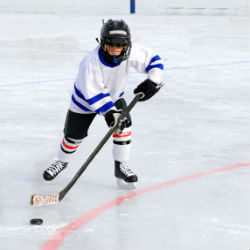Concussions are not a game

Monday, March 28, 2011 - 14:33
The Children’s Trauma Programs say: play it safe
By Christine Zeindler
He shoots, scores, and smashes into the boards. As he crumbles, his head thumps the ice. The crowd holds a collective breath until he stumbles to his feet. The hit didn’t look bad and yet the coach benches him for the rest of the game. A moan goes through the crowd: was this necessary?
According to Debbie Friedman, Trauma Director at The Montreal Children’s Hospital (MCH), the coach did the right thing. A blow to the head, if not treated in a timely manner, can have serious consequences “When a player is experiencing nausea, headache, dizziness or is vomiting, he is showing signs of a concussion and should be removed from the game immediately,” she says. “The player should be evaluated by a doctor as soon as possible. If he does have a concussion, he needs to take it seriously –his brain has been injured.”
“We only noticed Sébastien was unwell when we got home,” says Véronique Chartrand. Ten year-old Sébastien was tackled forcefully while playing football. “When he started vomiting and complained of a headache, we brought him to our local hospital and then, when his symptoms didn’t improve, to The Montreal Children’s.” He was diagnosed with a concussion and was referred to the MCH concussion clinic.
Helmets don’t always prevent concussions
A concussion is a disturbance in brain function caused by a direct hit to the head or body. “Helmets worn properly reduce the chances of severe brain injury, but may not completely protect the brain,” says Ms. Friedman. “The brain moves around in the skull. It can move from one side to the other during a hit or fall, causing the injury.”
Benching is the best therapy
Over 1,000 patients are treated with sports-related concussions at the MCH each year. Once diagnosed, these patients need time to heal. “For the first one to two weeks, rest is the only way to recover,” says Isabelle Gagnon, MCH trauma physiotherapist and researcher. “Athletes who play while showing symptoms risk further injury. Cumulative effects may result if another concussion happens soon afterwards.”
Returning to play
When players are symptom-free for at least a week, they can gradually increase their exercise over several days before returning to the game. “We understand the pressure on some of these kids to play,” says Ms. Friedman. “We tell them what to expect during recovery, provide guidance for a return to school and encourage their gradual safe return to activities.”
To help parents, coaches, teachers, and athletes better understand concussions and their impact, the MCH trauma experts have developed a number of resources. The Concussion KiT is an educational initiative designed to increase awareness of concussions and how to recognize and manage them. The MCH trauma website (www.thechildren.com/trauma) is also a good source of information.
“Concussions need to be respected and managed properly,” says Ms. Friedman, “otherwise the consequences can be significant and persistent, resulting in life-long disabilities for kids and teens.”


